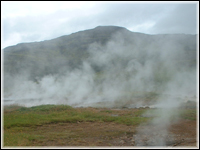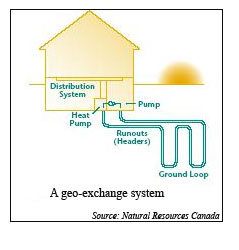Making Sense of Geothermal Energy
 Vancouver, Canada (GLOBE-Net) – Geothermal, or earth energy, is perhaps the most underutilized renewable source of energy. Whether using the earth’s naturally stable temperature to provide heating and cooling, or harnessing extreme heat from deep below the earth’s surface to generate electricity, the potential of geothermal energy has until now been largely untapped. But the geothermal marketplace is growing fast. Understanding the current technologies involved and the economics behind them can help building designers, business executives, and homeowners to take advantage of this renewable, clean and efficient energy source.
Vancouver, Canada (GLOBE-Net) – Geothermal, or earth energy, is perhaps the most underutilized renewable source of energy. Whether using the earth’s naturally stable temperature to provide heating and cooling, or harnessing extreme heat from deep below the earth’s surface to generate electricity, the potential of geothermal energy has until now been largely untapped. But the geothermal marketplace is growing fast. Understanding the current technologies involved and the economics behind them can help building designers, business executives, and homeowners to take advantage of this renewable, clean and efficient energy source.
There are two types of energy that fall under the geothermal category, each markedly different from the other.
Ground-source heating and cooling
A ground source heat pump, also known as a geo-exchange system, utilizes the near-constant temperature of soil just beneath the earth’s surface to heat or cool a building. Geo-exchange systems consist of an external loop of piping buried in the ground below the frost line, and an internal loop of piping within the building, filled with water or a mixture of water and chemicals.

The temperature below-ground maintains a steady 10°C to 15°C year-round, so the fluid absorbs heat in the winter and transfers it to the house, while in summer heat from the house will be transferred outside. The ‘balance point’, or the outdoor temperature at which a geo-exchange system can fully satisfy indoor heating requirements, is around -10 degrees Celsius in most regions of Canada with current technologies. Below that auxiliary heat sources are required, though newer technologies are continually extending that range.
Geo-exchange is a proven technology that is now in use in all Canadian provinces. Natural Resources Canada (NRCan) estimates there are over 33,000 earth energy systems being used in Canada’s residential, commercial, and institutional sectors, with sales increasing by about 13% annually. Many new sustainable building employ heat pumps, including commercial and residential developments.
According to industry figures, geothermal heat pumps can reduce home heating and cooling costs by up to 70% annually, providing a stable source of both heating and cooling. The savings, as well as reduced exposure to fluctuating energy prices, are key to offsetting the estimated $13,000 to $15,000 cost of installing a system for a 2,000-sq.-ft. house.
Geothermal steam energy
The other type of geothermal energy involves harnessing the earth’s more extreme temperatures to create steam to drive a turbine and to produce electricity. This technique has been in use for over a century, with an estimated 10,000 MW of electrical capacity and ten times that amount of thermal energy capacity installed worldwide as of 2000. In 2003, this type of geothermal power supplied just 0.416% of the world’s energy, reports the International Energy Agency (IEA), indicating tremendous potential for expansion.
Generally, finding high enough temperatures requires drilling several kilometres deep. Geothermal reservoirs that are at least 240 degrees Celsius are required to generate high pressure hot water to create steam, although other methods can tap less extreme temperatures by using liquids with lower boiling points.
While high-grade ‘hydrothermal’ resources are found all over the world, in many cases natural reservoirs are not sufficiently porous or permeable to support commercial power production. In these cases, the reservoirs can be ‘stimulated’, sometimes by pumping water or chemical mixtures through the structures to open up new cracks and to interconnect geothermal pools to create a viable heat source.
This method is called Enhanced Geothermal Systems (EGS), and studies indicate it could play a significant role in our energy future, as an environmentally-friendly power generation method with potentially positive economics.
Last year, an MIT study (PDF) evaluated the potential for EGS in the United States concluding that it could supply a substantial portion of the country’s electricity in the future, probably at competitive prices and with minimal environmental impact. EGS techniques could greatly increase the fraction of the geothermal sites that could be developed commercially, beyond available high-grade hydrothermal resources. With an investment of $1 billion over the next fifteen years, geothermal could provide at least 10 percent of U.S. electricity by 2050, says the expert panel behind the report.
Interestingly, the drilling and reservoir technologies used to mine heat have many similarities to those used for extracting oil and gas, connecting the geothermal industry to global energy giants. The MIT panel suggests increased investment by oil and gas firms and electric utilities, supported by federal R&D programs. Though the potential for EGS is great, practical demonstrations, improved resource mapping, and some technical advancements will be required to fully realize its potential and make it a major energy contributor in North America, says the report.
Deploying Geothermal Solutions
The good news is that the experts believe such a transition is possible, and it seems that geothermal is yet another renewable energy resource poised for growth. Though it has received less publicity than hydrogen, solar or wind energy, geothermal possesses many of the positive characteristics of other renewable energies without some of the potential drawbacks.
The great advantage of geothermal is a feature it shares with solar and wind energy: a lack of fuel inputs means the system costs less to run and is not subject to fluctuating fossil fuel prices. Even with high upfront costs, geo-exchange systems are generally proven cost-effective, and commercial geothermal can also take advantage of low operating costs to produce competitive power. The other great advantage is that geo-exchange and hydrothermal technologies are well developed and proven in a variety of applications.
One study from NRCan evaluated the cost of using an earth energy system in 135 commercial and institutional scenarios, including elementary and high schools, senior-citizen complexes, high-technology facilities, curling rinks and hockey arena, mid-sized hotels and motels, suburban offices, retail strip malls and high-rise condominiums. In 133 of 135 scenarios, earth energy was found to be less expensive over the life of the system when compared to systems such as gas- or oil-fired boilers. Geo-exchange total costs were deemed to be marginal in eight scenarios, while in 88 scenarios, the simple payback period was less than five years.
Geo-exchange is a well proven technology, and could feasibly be installed in the majority of new residential and commercial developments in Canada. Heat pumps are being employed at Victoria’s Dockside Green sustainable building development, and most new ‘green’ projects involve heat pumps in combination with high efficiency heating systems and insulation to for an energy efficient, low-emissions building. Enwave’s Deep Lake Water Cooling system adapts the concept to cool over 140 buildings in downtown Toronto using steady temperatures at the bottom of Lake Ontario. In an effort to address the upfront costs of geo-exchange, two Ontario companies - Waterloo North Hydro and NextEnergy - have formed a joint venture to offer customers ability to buy geothermal systems with a single monthly bill.
Such creative financing methods, enhanced buyer and builder awareness, and public sector support should help to continue strong growth rates for geo-exchange systems in Canada. There is much room for growth, as a Canadian Electricity Association (CEA) market study in 2002 identified a $1.6 billion annual potential market for geo-exchange – $619 million in Ontario alone.
For large-scale commercial electricity generation, a more targeted effort is likely required from industry and government.
In Canada, Vancouver-based Western GeoPower Corporation is exploring a potential geothermal site in South-western British Columbia, identified by BC Hydro in the early 1980s. Feasibility studies currently underway indicate the South Meager site could support up to a 100 MW power plant.
The company also holds a lease in the famed Geysers field near San Francisco, one of North America’s oldest geothermal sites, and plans to develop a 25.5 MW installation there. Another Canadian company, Toronto’s Polaris Geothermal, has plans for a 66 MW plant in Nicaragua.
Canada’s oil and gas industry may provide a chance for more domestic geothermal development, as a consortium of energy firms is investigating the possibility of using geo-sourced steam to displace natural gas use in the oil sands industry. The group is targeting its first project at Suncor’s Firebag in situ operation, and could optimistically have a pilot running within three years.
Increased interest in all types of geothermal energy is an excellent sign that a variety of options are being explored to resolve the challenging issues surrounding energy and the environment. As a proven technology with vast potential, geothermal energy is poised to take an increasing share of attention and investment dollars over the next several decades.
You can return to the main Market News page, or press the Back button on your browser.

